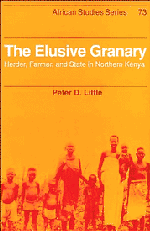Book contents
- Frontmatter
- Contents
- List of illustrations
- List of tables
- Preface
- 1 Introduction: the study of agrarian change among African herders
- 2 Society, ecology, and history
- 3 Markets and the state
- 4 Labor and agropastoral production
- 5 Income, wages, and investment
- 6 Expenditures, consumption, and the food crisis
- 7 Land conflicts and sustainability
- 8 In pursuit of the granary: development responses of community, donor, and state
- Notes
- References
- Index
- AFRICAN STUDIES SERIES
6 - Expenditures, consumption, and the food crisis
Published online by Cambridge University Press: 04 August 2010
- Frontmatter
- Contents
- List of illustrations
- List of tables
- Preface
- 1 Introduction: the study of agrarian change among African herders
- 2 Society, ecology, and history
- 3 Markets and the state
- 4 Labor and agropastoral production
- 5 Income, wages, and investment
- 6 Expenditures, consumption, and the food crisis
- 7 Land conflicts and sustainability
- 8 In pursuit of the granary: development responses of community, donor, and state
- Notes
- References
- Index
- AFRICAN STUDIES SERIES
Summary
The sources of income discussed in the previous chapter make up one side of an equation, the other side of which is expenditures, representing the uses of these homestead revenues. This chapter addresses expenditures and consumption, paying particular attention to the effects of poverty and differentiation. It draws attention to: (1) the increased importance of nonpastoral products in the local diet; (2) the seasonality of consumption and expenditure patterns; (3) the consumption and budget crises among poor and very-poor homesteads; and (4) relationships among income, consumption, and expenditures. At a more general level, the chapter examines grain deficits in II Chamus and the importation of food aid into the local economy, pointing out the great increases in such aid in the 1980s. The chapter argues that when expenditure and consumption patterns are assessed, Hyden's (1980) “exit option” becomes increasingly unrealistic. While local production is poorly integrated into the market, homesteads nevertheless are highly dependent on the market for purchases of food.
Increased dependence on maize
Chapter 3 demonstrated the extent to which grain imports have increased in II Chamus during the past fifty years. An important reason for this is a reduced livestock-to-people ratio that forces homesteads to depend more on consumption of agricultural as opposed to animal products, a problem aggravated by local inequities in livestock ownership. The long-term trend, which has been accelerated by recent droughts, has been toward a general reduction in herd size per family and per capita. Population has outpaced gains in local herds, accounting for some of the decline.
- Type
- Chapter
- Information
- The Elusive GranaryHerder, Farmer, and State in Northern Kenya, pp. 117 - 134Publisher: Cambridge University PressPrint publication year: 1992



